If you think resistance bands aren’t home gym essentials, you’re missing out. I’m a former college athlete, CrossFit enthusiast, and competitive beach volleyball player who can also sport climb up to a 5.12a grade, and I use resistance bands daily for warmups, prehab, rehab, and simple super-sets. Unlike other standard weight training tools, I can take them with me anywhere. And if you’re serious about getting strong, bands can help improve your total on the big three — bench press, squat, and deadlift.
There are, however, many types of bands. There are bands with handles, bands that help you complete a pull-up, and bands for your butt. Feeling a little overwhelmed? Yeah, we get it. We’ve tried and tested the best products on the market and compiled the best resistance bands — broken down into categories — to help you pick the ideal one for you. Here are our top choices.
Best Resistance Bands
- Best Resistance Bands Overall: REP Fitness Tube Resistance Bands with Handles
- Best Budget Resistance Bands: Titan Fitness Light Resistance Bands
- Best Resistance Bands Home Gym: TRX Rip Trainer
- Best Resistance Bands for Prehab/Rehab: Crossover Symmetry
- Best Resistance Bands for Pull-Ups: Fringe Sport Resistance Bands
- Best Resistance Bands for Glutes: Iron Bull Mini Bands
- Best Hip Circle Band: Slingshot Hip Circle Max
- Best Tube Resistance Bands: Rogue Tube Bands
How We Tested and Chose the Best Resistance Bands
The team here at BarBend is filled with CrossFit professionals, former D.1 athletes, and fitness enthusiasts who have tried and tested 17 of the top resistance bands to provide you with an honest review of our favorites. We’ve utilized a multi-point methodology scoring each item on a 1 (boo, not impressed) to 5 (we love it!) scale in categories such as durability, adjustability, and ease of use. Here are the aspects of bands that we evaluated for our top picks.
Level of Resistance
A critical decision to make when purchasing a resistance band is how much resistance you’ll need. We took into account the range of lighter and heavier resistance band weights that are best suited for certain exercises. Lighter bands between 3 and 30 pounds of resistance may be better for stretching or accessory work like face pulls and lateral raises. Band-assisted squats, deadlifts, and pull-ups call for heavier bands to be used, usually ranging from 40 to 170 pounds of resistance. On this list, you’ll find brands that offer a variety of different weights — from as light as 3 pounds up to 170 pounds.
Accouterments
Some sets of resistance bands come with additional tools that might enhance the experience. Commonly included are door anchors (which provide a static point from which the resistance bands can be pulled), soft-grip handles (which allow pulling and pushing exercises), and carabiners to swap out your resistance band or add on more. Resistance band loops will typically serve different exercises like assisted pull-ups or glute-activating lateral walks and won’t utilize these add-ons.
Color Coding
Colored bands won’t help your gains, but they will help you stay organized. We’ve opted for brands with color-coded bands to signify specific resistance levels. Over time, you’ll be able to associate each band with their assigned weight (even if you’re half-asleep during an early morning workout).
Best Resistance Bands Overall: REP Fitness Tube Resistance Bands with Handles
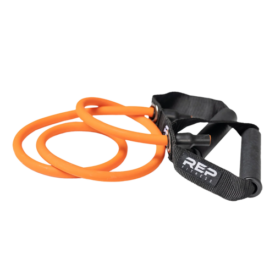
This set of resistance bands with handles comes in three different color-coded resistance options, and the resilient handles are designed to provide a firm, secure grip.
Specs
- Price: $21.99
- Type of Band: Tube band with handles
- Level of Resistance: Light, medium, and heavy
- Colors: Blue, orange, black
- Materials: Latex
Pros
- These bands come in three levels of color-coded resistance so you can easily grab the right band for your workout.
- You can purchase each band individually, from $14.99 to $16.99, or get all three in a discounted $21.99 bundle.
- The attached handles make doing push or pull workouts more ergonomic than when using bands without handles.
Cons
- The amount of resistance on these bands isn’t noted, so you won’t know how much you’re lifting.
- These resistance bands contain latex, so those with allergies should take note.
Within your iron oasis, resistance bands are a relatively inexpensive item that you can add for versatility. You can use them to accommodate resistance training, help with stretching, or perform prehab/rehab exercises. Our favorite set overall is from REP Fitness. Ergonomics, functionality, and portability all scored a 5 out of 5.
[Related: The Best Water Bottles For Sports, Flip Tops, and More]

REP Fitness Tube Resistance Bands with Handles come in three easy-to-identify color-coded resistance capabilities: gray for light, orange for medium, and black for heavy resistance. Plus, the attached handles make doing push and pull movements easier and more ergonomic as compared to loop bands. Since dislocating my shoulder a decade ago, these bands have been my favorite tool for interior/exterior rotator cuff work. Ease of use scored a 5 out of 5.
You can purchase each band individually — from $14.99 to $16.99 — or get all three in a discounted $21.99 bundle. These prices are about $5 more expensive than similar items I’ve tried from Amazon, but REP’s bands are known for their durability and come with a 1-year home use warranty. However, those with a latex allergy should take note since these bands are made with latex.
I’ve been using these types of bands for the last 10 years and most recently used them to warm up my shoulders the last several weekends before playing beach volleyball. They’re also lightweight enough to slip into my purse whenever I leave the house, a benefit also pointed out by Amanda Capritto, certified personal trainer and our expert reviewer. “Resistance bands, for instance, are lightweight and require very little storage space, and can easily be brought on a road trip or packed into an airplane carry-on.” For this reason, I rated their portability a 5 out of 5.
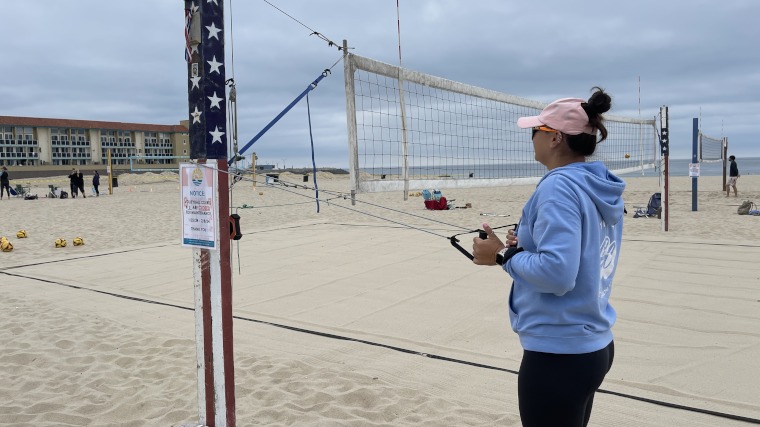
I like wrapping the band around a fixed point for chest presses, rows, or even lower body donkey kicks. Functionality scored a 5 out of 5.
Keep in mind, though, that the weight that you’re lifting with these bands isn’t noted, so it’ll be hard to track the amount of training volume outside of your completed sets and reps for strength and hypertrophy work. For this reason, I gave optionality and adjustments a 4 out of 5.
[Related: Hypertrophy vs. Strength Training: Key Differences + How To Do Both]
Best Budget Resistance Bands: Titan Fitness Light Resistance Bands
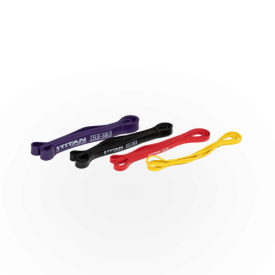
This bundle of latex superbands provides four resistance bands, ranging in resistance from 2-15lbs up to 25-80lbs. Loop these around a pull-up bar for assisted pull-ups, or attach them to your barbell to add resistance or assistance throughout your lift.
Specs
- Price: $74.99
- Type of Band: Superband
- Level of Resistance: 2-15lbs; 5-35lbs; 10-50lbs; 25-80lbs
- Colors: Yellow, red, black, purple
- Materials: Latex
Pros
- For $74.99, each band comes out to about $18.74, which is between $2 and $30 less expensive than similar bands from top brands.
- While these types of resistance bands aren’t meant to last a lifetime, Titan Fitness offers an affordable protection plan at $8.99 for 2 years or $11.99 for 3 years.
- This bundle is versatile, with options for stretching, calisthenics, strength, hypertrophy work, and pull-up assistance.
Cons
- Users looking for handles on their resistance bands won’t find them on this product.
- These bands are made with a latex rubber, so those with a latex allergy should avoid them.
Resistance bands come in a variety of options and can vary in price drastically depending on the purpose, extras they come with, and resistance they provide. While they’re typically not as expensive as the best power racks, some resistance bands offer a more budget-friendly price point than others — like the Titan Fitness Light Resistance Bands. Functionality, portability, and workout experience scored a 5 out of 5.
For $74.99 you’re getting a pack of four bands, ranging from the yellow band’s light 2-15 pound resistance, up to the purple band’s 25-80 pound resistance. This bundling of bands comes out to $18.74 per band when divided equally, which is between $2 and $30 less expensive than comparable bands. Value scored a 4 out of 5. I docked one point because, while it’s a good deal for the bundle, its value depends on whether you need all four bands. For example, I’d only need the purple and yellow bands for my routine.
These types of latex bands, no matter how strong, will eventually snap, which is why durability initially scored a 4 out of 5 — until I noticed the Titan Fitness protection plan. You can protect your purchase with a reasonable $8.99 for 2 years of protection or $11.99 for 3 years. That means should your band have any problems, you can make a claim and get a free replacement without any additional fees.

I’ve used these types of bands before for forward-banded deadlifts, and gave this specific brand a whirl to help me warm up before rock climbing. Their versatility is really nice, as I used them to warm up, strength train, and during pull-ups. Users looking for handles on their resistance bands won’t find them here. Instead, I just held onto the end of the loop for a few sets of rows, presses, lunges, bicep curls, and interior/exterior rotator cuff work.
They’re small and lightweight, so keeping the bands permanently in my climbing bag isn’t a pain at all. Portability scored a 5 out of 5. However, they are constructed out of rubber latex and don’t have handles, so users with a latex allergy or those looking for an ergonomic grip may want to look elsewhere. Ease of use scored a 4 out of 5.
Best Resistance Bands for Home Gym: TRX Rip Trainer

Have you ever wanted a full-body workout device that can fit in your backpack? If so, the TRX Rip Trainer is the answer with a resistance band-style full-body system that you can set up nearly anywhere in seconds. Don’t let the light resistance fool you — this product means business.
Specs
- Price: $229.95
- Type of Band: Lightweight bungee cord system
- Level of Resistance: 20lb medium resistance bungee (lite to XX-heavy cords sold separately)
- Colors: Yellow and black
- Materials: Steel bar with rubber handles
Pros
- This portable trainer can easily attach to a door, tree, pole, or anything else you might have available in your home gym.
- The Rip Trainer is ideal for athletes who want to train their rotational power for sports like baseball, softball, tennis, or ultimate frisbee.
- The two-piece weighted bar twists apart, so you can store all of your gear in the included carry bag.
Cons
- The $229.95 price tag is a bigger investment than the $20 to $80 resistance bands we’ve tried and tested.
- This system primarily benefits core strength, so those wanting to train their upper or lower body should look elsewhere.
- Unlike other resistance bands, the TRX Rip Trainer needs a fixed anchor to attach to.
While space is often a concern for those building out their home gyms, equipment that stores easily and doesn’t take up a lot of room is ideal. The TRX Rip Trainer is a weighted bar that attaches to a bungee cord that’s fixed to an anchor. With rotational training front and center, you can squeeze in a 30-minute HIIT workout to strengthen your core by attaching the industrial-strength carabiner to a door, tree, pole, or any other fixed object in your home gym.
When not in use, the bar twists apart, allowing everything to fit inside a small carry bag. This makes storing this in your closet, under furniture, or even in drawers easy. At 6.5 pounds, you’ll also be able to carry this equipment with you to get in your workout from wherever you want — hotel rooms, the office, even the park when you’re supposed to be watching your child’s t-ball game. This portability scores a 5 out of 5.
Its $229.95 price tag is high compared to the $20 to $80 resistance bands we’ve tested, but this product offers targeted rotational training for beginner and experienced athletes working out from home. The nature of Rip Trainer is ideal for users who want to train for sports like golf, baseball, softball, tennis, or ultimate frisbee.
This rotational strength exercise builds explosiveness and puts your core front and center, so those looking for a resistance band workout to focus on building strength in their legs and upper body may want to look at other options.
In the TRX Rip Trainer Kit, you’ll receive the Rip Trainer Baton, resistance cord, door anchor, and safety strap, which has got you covered in case your grip slips during a workout. Unlike other resistance bands, you’ll need a fixed anchor in your home gym to attach this trainer to. Additionally, the kit includes an instructional guide with suggested workouts and a carry bag for easy portability.
Best Resistance Bands for Prehab/Rehab: Crossover Symmetry
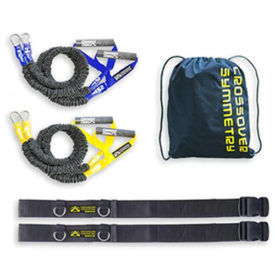
Developed by physical therapists, athletes, and coaches, this unique band system can help fortify your shoulders for longevity, mobility, and strength.
Specs
- Price: $199.95
- Type of Band: Anchored bands with handles for recovery work
- Level of Resistance: 3lbs, 7lbs, 10lbs, 15lbs, 25lbs, and 40lb
- Colors: Green, purple, yellow, red, blue, orange
- Materials: Plastic handles, nylon sleeve, rubber cord
Pros
- The Crossover Symmetry was developed by physical therapists to reduce shoulder pain as part of a rehabilitation program.
- Suited for golfers, swimmers, and baseball players, this can help increase overhead strength, throwing power, and shoulder stamina.
- The Crossover System takes the guesswork out of prehab and rehab, providing you with a training guide, exercise chart, and access to the online training zone.
Cons
- This model is meant for prehab and rehab, so if you want bands that can be used to perform more traditional exercises, you’ll want to look elsewhere.
- At $199, the Crossover Symmetry is high quality, but it does cost nearly $110 to $160 more than traditional resistance bands.
- While we appreciate self-guided workouts, those with serious shoulder injuries will want to utilize guided physical therapy from a professional.
Designed specifically for shoulder health, Crossover Symmetry can help facilitate some of the best shoulder warmup exercises to help aid in recovery. Popular in CrossFit gyms and in-home gym settings, this system scored a 5 out of 5 for delivery, setup, and materials.
Crossover Symmetry was developed in part by physical therapists, coaches, and athletes to alleviate and prevent shoulder pain. The two separate cords — available in 3, 7, 10, 15, 25, and 40 pounds — must be individually attached to an anchor point, such as a power rack or one of Crossover Symmetry’s custom anchors. “The bungee cords are good quality, but the door anchor felt a little uncertain. It didn’t break or anything, but I really had to put my weight into pulling it taut,” noted our tester, a certified personal trainer. Durability scored a 4 out of 5.
The elastic bands are also encased in a protective sleeve to help improve durability since these are intended to be used daily. This nylon-covered dipped latex scored a 5 out of 5 for materials.
Crossover Symmetry also provides training programs, an exercise chart, and access to an online training zone with many of the best shoulder exercises to help eliminate shoulder pain.
The included programs focus on activation, recovery, strength, and mobility with instructions that are easy to follow. If you’re not looking for a dedicated shoulder prehab/rehab, you may want to look elsewhere. Additionally, those with serious shoulder injuries should consult with a physical therapy professional rather than attempting self-guided programming.
Value scored a 4 out of 5. “For $199, you’re paying for the prehab/rehab programming. Crossover’s library of workout routines shows you how to properly use the bands for rehab, and it’s an impressive library for that,” noted our tester. However, if you’re looking for extra-heavy resistance bands to build muscle, you may want to look elsewhere.
Whether you’re working to maintain shoulder health or trying to rehab nagging pain from the CrossFit Nancy workout, the Crossover Symmetry can be a useful tool. However, if you’re looking for bands with enough resistance to build muscle in your larger lifts, you’ll need to look elsewhere.
Best Resistance Bands for Pull-Ups: Fringe Sport Resistance Bands
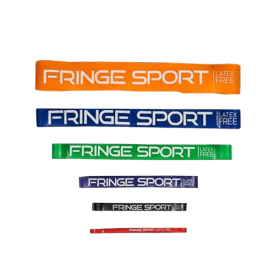
These latex-free resistance bands provide between 20 and 175 pounds of resistance, perfect for assisting with pull-ups, stretching, and attaching to a barbell for added resistance in your bench press or deadlift.
Specs
- Price: Starting at $28
- Type of Band: Superband
- Level of Resistance: 20-35lbs; 30-50lbs; 40-80lbs; 50-120lbs; 60-150lbs; 70-175lbs
- Colors: Red, black, purple, green, blue, orange
- Materials: Latex-free rubber
Pros
- These 40-inch long bands can wrap around a pull-up bar to aid in pull-ups or chin-ups.
- Unlike many bands we’ve tested, these are latex-free.
- Fringe offers a 1-year warranty.
Cons
- Bundle options are about $20 more expensive than comparable bundles we’ve tested.
- These rubber bands are unlikely to last as long as options made with latex. (1)
When I first started doing CrossFit, I didn’t have the strength to do a pull-up, but these types of pull-up bands, paired with a pull-up training program for beginners, made completing my reps possible. With the Fringe Sport resistance bands, you can slip the band over the bar, step into the loop, and then pull-up with assistance. I wasn’t able to do a single pull-up when I first started using these types of bands, but now I can easily bust out 10.
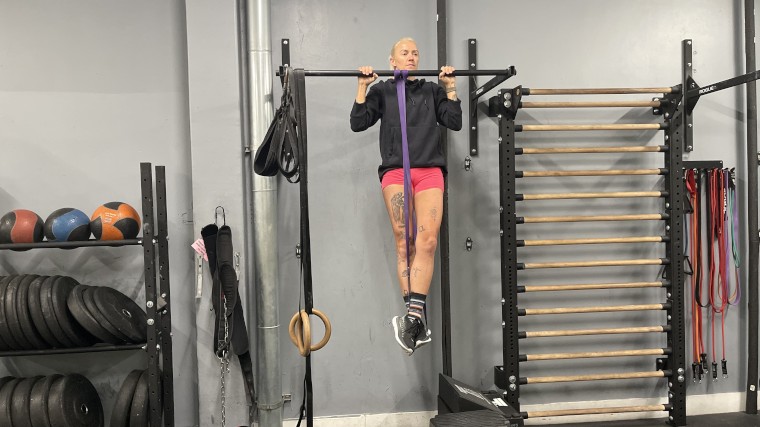
Comfort scored a 4 out of 5. Stepping into these for the pull-up assist can be a little tricky and someone with limited mobility may find it to be a struggle. Additionally, when using the 40- to 80- pound purple band for deadlifts, the band dug into my neck and wasn’t very comfortable. I’d rather do a deadlift with heavy weights than use a resistance loop. Because of this, I rated my workout experience a 4 out of 5.
While I’d recommend these bands primarily for pull-up assistance, the more creative you are, the more exercises they can accommodate. Squats, glute bridges, push-ups, shoulder rehab, bicep curls — truly, the list goes on and on. Just stand on the rubber band, or fix it to an anchor by wrapping it around, and you can push and pull to your heart’s content. Adjustments and optionality scored a 5 out of 5.
Durability scored a 3 out of 5. The .13-inch thickness of this band is comparable to other superbands I’ve tried, but the lack of latex — while a benefit for those with latex sensitivity — is unlikely to last as long as a latex product. (1) However, Fringe Sport offers a 1-year warranty, so you may be able to get a replacement based on how the band broke or snapped.
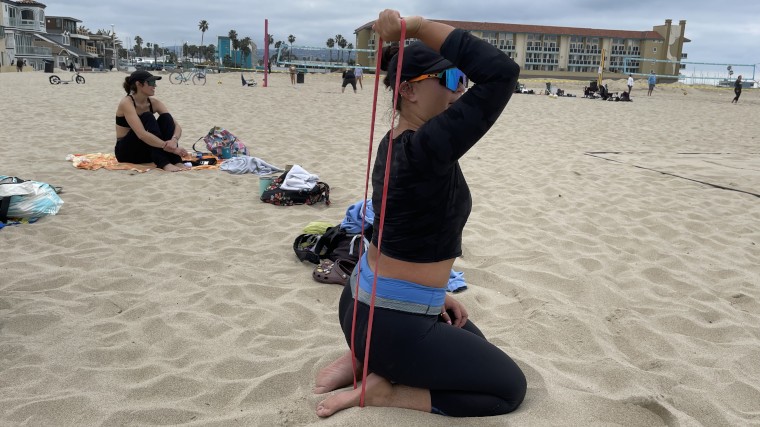
Some brands only offer their bands in bundles, and while Fringe Sport offers bundles, you can also buy bands individually at a price of $28 to $50. However, the bundle options for these bands are more expensive than what we’ve seen elsewhere. Bundle options range in price from $76 to $89 for three bands, which provides one less band than similarly-priced bundles.
[Related: Best Pull-Up Assist Bands For Travel, Advanced Athletes, And More]
Best Resistance Bands for Glutes: Iron Bull Mini Bands
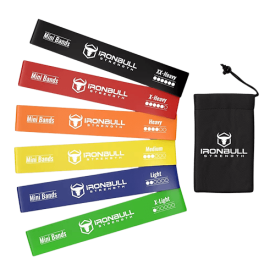
The 5 pack of mini bands ranges in resistance from X-Light to XX-Heavy, so you can train with progressive overload or activate your glutes before you lift heavy.
Specs
- Price: $25
- Band Style: Latex mini band
- Level of Resistance: X-Light; Light; Medium; Heavy; X-Heavy; XX-Heavy
- Colors: Green, blue, yellow, orange, red, black
- Materials: Natural latex
Pros
- Mini bands are great for glute training, as they can activate all three gluteal muscles and build muscle size through increased time under tension.
- This bundle provides six different levels of resistance — ideal for progressive overload.
- The bands are lightweight and portable enough to slip in gym bags, backpacks, and purses.
- At $25 for the pack, each band costs a little more than $4 a pop, making them some of the most affordable mini bands we’ve seen.
Cons
- Due to their thin elastic construction, mini-bands have short life spans, and these feel like they won’t last very long.
- While great for glutes, these bands aren’t suited for resistance training for squats or pull-up assistance.
The best resistance bands for glutes are often mini bands or hip circles, as they allow you to slip the band above your knees to help activate your glutes with standalone exercises like lateral squat walk or deadlifts. Mini bands can help activate all three of your gluteal muscles and the increased time under tension has been shown to aid in muscle growth. (2) Iron Bull Mini Bands provide you with a six-pack of mini bands for $25, which comes out to a little more than $4 per band.
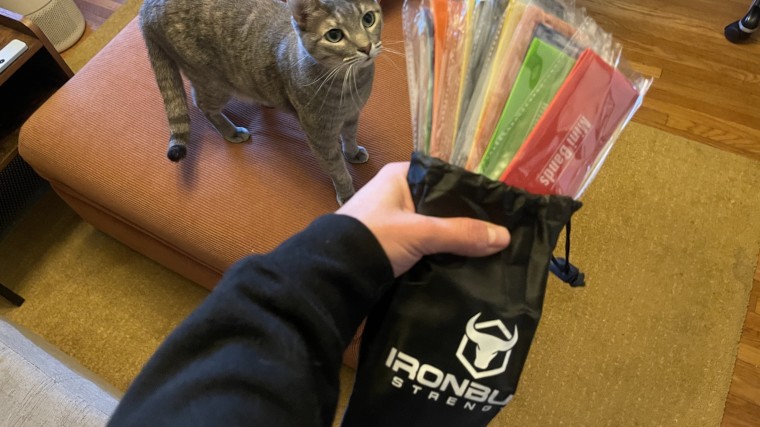
Their compact nature makes having one on you whenever you want to hit your glutes totally possible. Portability scored a 5 out of 5. I keep one mini band in my climbing bag and in my beach bag. I also like taking one on flights with me, as I can slip it on and do some hip abductor work while seated. I’m also able to use the mini bands to target my shoulders and biceps without totally annoying the poor person seated beside me.
You’re getting a variety of resistance in this five-pack — from X-Light up to the XX-Heavy. I like this variety for training my glutes, as I can make sure to keep progressive overload in mind. To build my glutes, I want to make sure I’m constantly challenging myself with resistance, so when I’ve performed a movement over a week or two and it’s feeling easy, I can swap in a heavier band. Overall workout experience scored a 5 out of 5.
These feel more durable than some of the other mini-bands I’ve tried in the past. That said, natural latex and rubber mini bands are inherently not the most durable products, so don’t expect these to last more than a year with consistent use. Durability scored a 4 out of 5. I’ve been testing these for two weeks and while they feel really strong, I know from experience that they’ll lose their elasticity overtime or will eventually snap.

Mini bands are excellent for targeting your glutes, but if you’re looking for a resistance band to assist pull-ups or to use in place of weighted resistance for deadlifts or squats, you’ll want to look elsewhere. However, if you’re ready to tackle resistance band exercises for glutes, the Iron Bull mini bands provide.
Best Hip Circle Bands: Slingshot Hip Circle Max

This band is looped around your knees so you can squat and walk in it to activate and prime your glutes and adductors for leg day.
Specs
- Price: $20
- Band Style: Fabric mini band
- Level of Resistance: Level 2 resistance
- Colors: Blue, gray black, gray white, pink, purple
- Materials: Rubber fabric
Pros
- This hip circle band helps cue users to keep their knees out while squatting.
- Fabric bands, as compared to the rubber and latex bands, can provide added resistance and comfort for users.
- The 3-inch wide hip circle won’t pinch or roll like similar mini bands.
Cons
- If you’re looking for a resistance band to tackle more than your warmup, you’ll want to look elsewhere.
- You only get one band, so there’s no opportunity for progressive overload or upping the resistance.
Hip circle bands were made for lifters by lifters to help them warm up before performing lower body exercises. The Slingshot Hip Circle Max is a 3-inch fabric band that we think provides a more comfortable experience than the rubber and latex mini bands that may dig into and roll up on legs while in use.
To use the Slingshot hip circle, you step inside it with both legs, position it above your knees, and then perform various walking movements. You can assume an athletic stance and walk laterally, forward, or backward, or use them during bodyweight squats. While lifting with a barbell, users can even find a benefit in wearing one to help keep knees from caving in.
The Hip Circle Max is made with a stiffer material than the original Hip Circle, providing users more resistance. This band will compress your legs, forcing you to drive your knees out to maintain a normal stance. As a result, your glutes and abductors will fire on all cylinders, which you want before loading them up on the front squat or leg press.
Glute activation can be a difficult sensation to attain for many lifters and the Hip Circle is designed to help with that. If you’re a serious lifter who prioritizes warming up before squats — which you probably should — then the Sling Shot Hip Circle Max is an ideal addition to your gym bag. However, if you’re looking for a resistance band to assist with pull-ups or in place of weighted resistance for deadlifts, lunges, or squats, you’ll want to look elsewhere.
The Slingshot Hip Circle Max costs $20, and you only get one band with a level 2 resistance — the midpoint of Slingshot’s three available levels of resistance — so those looking for variety may want to seek out bundles with multiple resistance bands.
Best Tube Resistance Bands: Rogue Tube Bands

Rogue Tube Bands are perfect for performing banded versions of standard accessory moves, like curls, rows, and overhead presses. Throw them in your gym bag for your next workout.
Specs
- Price: Starting at $22
- Band Style: Tube band with handles
- Level of Resistance: 10lbs, 15lbs, 30lbs, 40lbs, 50lbs, and 60lbs
- Colors: Orange, red, blue, green, black, and purple
- Materials: Latex
Pros
- With handles on both ends of these tube bands, users can row, curl, push, and pull to target an assortment of muscle groups.
- The portability and ease of use of these bands make getting a workout in as simple as standing on the tube, grabbing onto the handles, and repping it out.
- There are 6 levels of resistance — from 10 pounds to 60 pounds.
Cons
- When bundled, you’ll only get one tube band of each resistance as compared to the pair you get when purchased individually.
- These bands max out at 60 pounds, which may be too light for some strength athletes.
If you’re looking for tube bands to aid with accessory movements, look no further than Rogue’s offering. You can use them to help with stretching, to perform prehab/rehab exercises, and for strength training. The attached handle allows for easier access to push and pull accessory work like rows, shoulder press, and lateral lifts. Resistance and delivery scored a 5 out of 5.
The main difference between Rogue’s monster bands and tube bands comes down to two points — usability and resistance. The tube bands, which are equipped with handles on both ends, are meant to be rowed, pushed overhead, and curled. Monster bands, while capable of those movements, are also able to be looped over barbells.
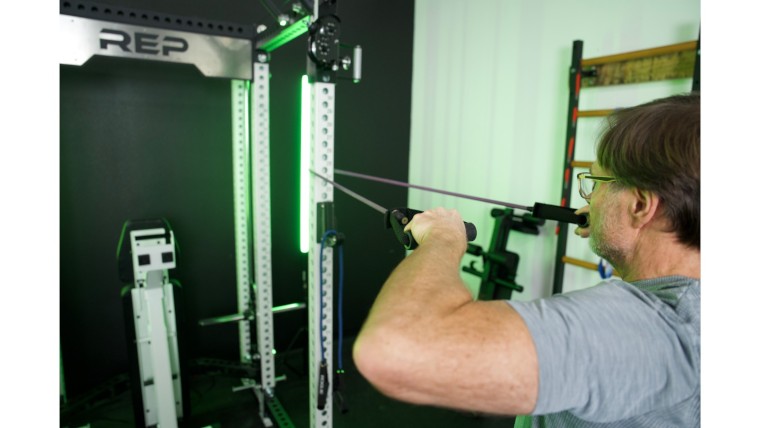
Rogue Tube Bands offer resistance in 10, 15, 30, 40, 50, and 60 pounds, with individual prices ranging between $22 to $32. You can also purchase a full set of bands for roughly $75. However, be aware that when purchased as a bundle, you’ll only get one band per level of resistance, as compared to the pair you get when purchased individually. Price scored a 4 out of 5 with our tester, a certified personal trainer, noting, “They’re expensive but likely because of their durable latex-based elastic.”
You can set these tube bands up for a number of exercises, including stiff-legged deadlifts, squats, good mornings, and overhead tricep extensions. If you want to perform banded accessory movements, like bicep curls, then these offer the design you want. Our tester gave optionality a 4.5 out of 5, noting, “The handles make these really versatile, however I struggled to do overhead presses because I’m tall.”
Some high-performing strength athletes may find even the toughest 60-pound tube band is too light for their workout, but most will find these suitable for accessory, rehab, and prehab work.
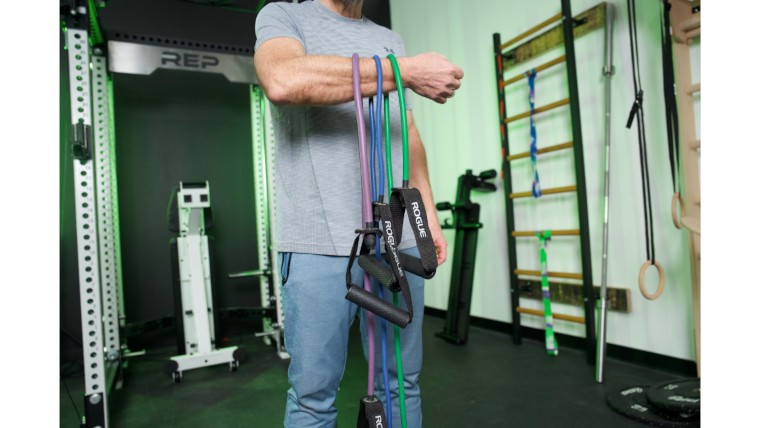
I’ve been using this type of band for the last 10 years and I love how lightweight and portable it is. I keep one tube band in my climbing bag and in my beach bag, so I’m always ready to warm up my shoulders before I play beach volleyball or rock climb. Sometimes, I use my feet as my anchor and other times I’ll wrap the band around a fixed point like a beam or a pole. I rated their portability and ease of use a 5 out of 5.
Benefits of Resistance Bands
Bands are typically made of elastic rubber and latex, and while we like that there are latex-free options available, it’s worth noting that rubber bands tend to be less durable than latex ones. (1) Here are some benefits of resistance band training.
More Muscular Tension
What makes bands unique is that they provide tension throughout an exercise’s entire range of motion. For example, when you’re doing a barbell curl, the weight is heaviest when it’s farthest away from your body — i.e., the mid-way point. Bands, however, are taut from the get-go, so your muscle will never get to relax. Because of the constant tension they provide, bands are a popular tool among bodybuilders to get a pump before posing on stage.
Joint-Friendly
What’s the main difference between squatting with 500 pounds on your back and an 80-pound resistance band? Your spine isn’t being compressed under the band — not nearly as much, at least. Because bands apply tension to your muscle throughout an exercise, you don’t need as much weight as using dumbbells or kettlebells. Over time, that can mean fewer potential injuries and nagging aches and pains. When it comes to band training, less really is more.
[Related: The Best Dumbbells for Any Budget and Fitness Goal]
Convenient and Compact
Resistance bands are small and lightweight, suitable for those in small spaces looking for access to resistance training. Amanda Capritto, a certified personal trainer and our expert reviewer, agrees. “It’s easy to get caught up in the glitz and glamor of sparkly, massive home gyms, but the reality is that most people don’t have the space or funds to recreate a commercial home gym in their home,” she says. “I live in a camper van and resistance bands provide me with a form of resistance training (and they regularly whip my butt, I might add).”
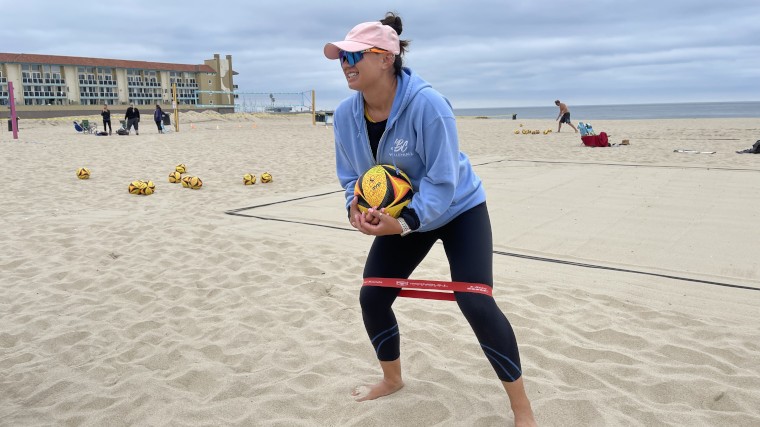
Additionally, if you’re on vacation, on a road trip, or simply unable to get to a gym, bands are a portable workout option. They’re low-maintenance, easy to use, and can fit into backpacks, purses, and gym bags to go where you go.
What to Consider Before Buying Resistance Bands
Not sure which resistance band is right for you? We’ve compiled some areas to consider before buying to hopefully help you choose the best bands for your training goals.
Price
These exercise resistance bands typically won’t set customers back that much in terms of price on their own, but those looking for added tools and gear will probably need to spend a bit more. Resistance bands that include anchoring gear typically will cost more than looped or mini-looped resistance bands.
The higher-end offerings that provide much more weight resistance will reflect that increased durability with its price. These can cost as much for a single band as whole sets of other brands do. If you are only looking to do some light resistance training, then a lower-cost and lower-resistance set is probably appropriate. Basic resistance bands range from around $13 to $45, while sets of bands tend to run between $30 to $75. Anchored trainers — like the TRX Rip Trainer or Crossover Symmetry — are usually more expensive and cost around $200.
Fitness Goals
Are you working on mobility and stability for a previously injured shoulder? Maybe you’re struggling to engage your glutes in your deadlift and need a little help. If you have a specific exercise that you are hoping to use the resistance bands for, you will probably have an easier time deciding which brand to get.
Not all bands are created equal, so you’ll need to know your goals to pick the right product for you. If you’re looking to work on your pullups, a superband is the right choice for you. An anchored trainer, meanwhile, can aid in rotational power for sports or provide prehab/rehab work to strengthen shoulders. Lastly, mini bands and hip circles can help you activate and strengthen your glutes.
Band Type
Tubes with handles are one of the most popular types of resistance bands since they’re easy to transport, have handles to improve ergonomics, and can be anchored by your own two feet.
Superbands are the best resistance bands for building muscle. They are large continuous loops — typically around 40 inches — which can be used to assist with pull-ups, add concentric and eccentric resistance to a barbell, and for stretching and mobility.
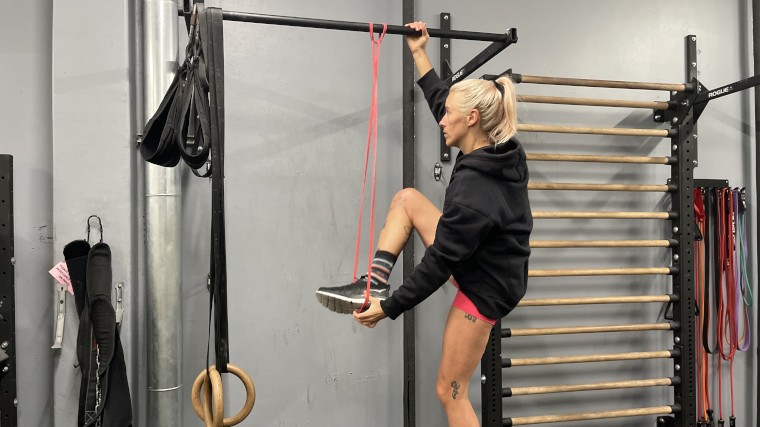
Mini bands come in latex or fabric, and are often worn on both legs above the knees to help activate the glutes. In addition, these bands are ideal for banded walks, lunges, yoga, and pilates-style exercises, as no additional tying or attachments should be necessary.
Anchored trainers come with anchors to attach the system to a door, squat rack, or pole. While these systems are usually more expensive, you’ll have more levels of resistance and types of usability at your disposal. These trainers are ideal for building power in your trunk rotation and in building strength and stability in shoulders to prevent or recover from injury.
Resistance Levels
If you know how much resistance you want or need, you’re all set. With tube bands, superbands, and whole body trainers, you can often increase resistance or intensity by moving further away from your anchored position. Additionally, if you’re unsure how much resistance you want, many of the options on the market provide bundles with multiple levels of resistance.
Lighter bands between 3 and 30 pounds of resistance may be better for accessory work that requires less resistance like shoulder stability and mobility work. Heavier bands ranging from 40 to 170 pounds of resistance will be better suited for and resistance to barbell movements and assisting with pull-ups.
If you plan on using a superband for pull-up assistance, you’ll want to take into consideration your weight and how strong your current pull-up is. If you’ve never done a pull-up before, you’ll want to opt for a resistance band that’ll take away enough of your weight to allow you to complete your reps. I’d recommend at least an 80-pound resistance superband or higher for the average individual.
| Resistance Range | Band Style | Material | Band Length | |
| REP Fitness Tube Resistance Bands with Handles | Light, medium, and heavy resistance | Tube band with handles | Rubber and latex, foam grip | Not listed, but personally measured from end to end: 55.5” |
| Titan Fitness Light Resistance Bands | Yellow: 2lb-15lb; Red: 5lb-35lb;Black: 10lb-50lb; Purple: 25lb-80lb | Superband | Rubber and latex | 41” |
| TRX Rip Trainer | 20lb medium resistance | Bungee cord | Bungee cord, steel core bar, rubber handles | 42.5” |
| Crossover Symmetry | 3-40lbs | Bungee cord | Elastic dipped latex bands encased in nylon sleeve | About 48” |
| Fringe Sport Resistance Bands | Red: 20-35lbs; Black: 30-50lbs;Purple: 40-80lbs;Green: 50-120lbs;Blue: 60-150lbs;Orange: 70-175lbs | Superband | Biomedical grade synthetic rubber | 40” |
| Iron Bull Mini Bands | X-Light to XX-Heavy | Mini-band | Natural latex | 12” |
| Slingshot Hip Circle Max | Level 2 resistance | Hip circle | Fabric (stiffer than original Hip Circle) | 13” – 15” |
| Rogue Tube Bands | Orange: 10lbs;Red: 15lbs;Blue: 30lbs;Green: 40lbs;Black: 50lbs;Purple: 60lbs | Tube band with handles | Latex based | 65” |
There are a wide range of resistance bands to fit your needs, whether that’s aiding in pull-ups, increasing resistance in your bench press or deadlift, or having something you can toss in your bag to do resistance training or stretching on the go.
Different Ways to Train With Bands
Bands are one of the most versatile pieces of training equipment. You can use bands to get a workout in or enhance a workout. Or, if you need some mobility work, bands can help limber you up. Here are some common ways to train with bands.
In Place of Weights
If you’re wondering how to build muscle, you don’t necessarily need a barbell and cumbersome weight plates. If you own a band, you can squat, press, row, and plank your way to more muscle or less fat. That said, one downside to training with bands is that you can’t track progression as easily — and progression is a major key to getting bigger and stronger.
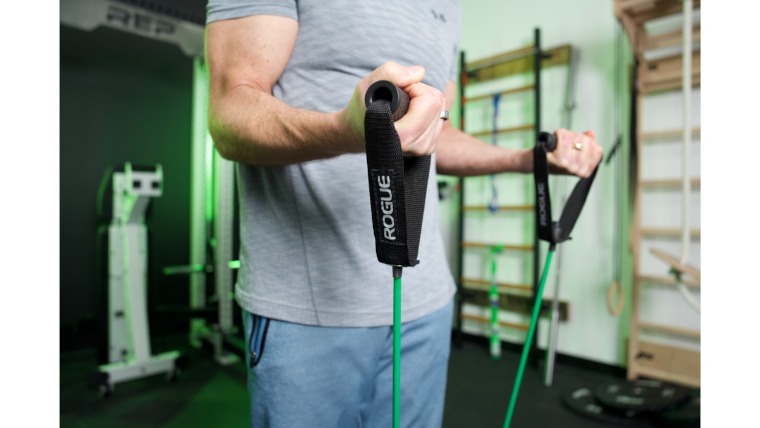
When a band claims to offer 50 pounds of resistance, simply moving your hands up or down an inch will make a move easier or harder. However, there’s no true way to know how much you’re lifting. You can keep track of reps, but it isn’t easy to objectively track your progress without knowing the actual load. That said, if you’re on a mission to be as strong as possible, then we doubt you’re training exclusively with bands.
If you want to build strength, move better, and be healthier, then focus on tempo training strength exercises, how many reps you’re doing, and cutting down rest time.
As a Part of Your Warm-Up
Bands are great for stretching and muscle activation. You can do moves like band pull-aparts, banded lateral walks, and banded versions of classic moves like deadlifts, squats, and rows to prime your body for heavy lifting.
They can provide just enough resistance to challenge your muscles without fatiguing them. Also, the constant tension bands ensure that your muscles are active during an entire range of motion. This is important because the best mobility exercises aren’t just about how long your range of motion is but how strong you are at the end of that ROM.
Added to Barbells and Machines
In the sport of powerlifting, it’s common for lifters to add bands to the big three lifts (deadlift, bench press, and back squat) to either pull down or up on the barbell, increasing the lift-off or lockout phase of the lift.
Say you loop a band around the center of a bar for deadlifts and stand over it. The bar is going to feel heavier as you pull it up, and the band gets tight. So, if you load the bar with 405 pounds, you’ll be pulling what feels like 405 pounds during the lift-off phase and — depending on how heavy of a band you use — let’s say 455 pounds at lockout. If you’re a lifter who is curious about how to improve your deadlift lockout, banded pulls may be the answer you’re looking for.
[Related: How to Use Resistance Bands to Increase Strength, Power, and One-Rep Maxes]
Final Word
In general, resistance bands provide a ton of versatility for a relatively cheap price. On top of that, they take up a small amount of room, making them a must for pretty much any gym or lifter. They’re easy to throw in your gym bag to pull out when you need them. Whether you’re warming up your shoulders, engaging your glutes, or performing accessory exercises, they pack a punch in a compact vessel. Resistance bands are often used by physical therapists for rehab and prehab too, providing yet another useful function.
Other types of resistance bands provide an entire workout on their own with a focus on stability and prehab to help prevent and manage injury risk. These may be more costly than loop types of bands, but they provide a unique and often fun challenge in addition to being extremely portable. It would be quite difficult to transport your entire home gym with you, but many band systems can be stored in a simple bag. The types of resistance bands are as versatile as the workouts you can do with them. For a generally low cost and high level of utility, picking up a few bands or a set is a must for avid lifters.
FAQs
What’s the best resistance band?
Truly, it depends on what your fitness goals are. However, the REP Fitness Tube Resistance Bands provide you with three levels of resistance at only $21.99. They also come with attached handles that make pushing and pulling easier as compared to resistance bands that require users to grip the band in an awkward manner.
How should I train with resistance bands?
However you want really. Bands can be used to stretch out your muscles. You can do exercises like squats, deadlifts, and curls with them for more muscle and strength. Or, if you’re a dedicated strength athlete, use them to make your barbell movements harder and easier at certain ranges of motion.
How much do resistance bands cost?
Resistance bands are generally inexpensive as far as gym equipment is concerned and single bands can cost in the range of $13 to $75. Sets of bands usually cost around $30 to $75, while whole gym solutions can range from about $195 to $229.95.
References
- Hwang, C. J., & Cha, J. Y. (2003). Mechanical and biological comparison of latex and silicone rubber bands. American journal of orthodontics and dentofacial orthopedics : official publication of the American Association of Orthodontists, its constituent societies, and the American Board of Orthodontics, 124(4), 379–386. https://doi.org/10.1016/s0889-5406(03)00564-x
- Burd, N. A., Andrews, R. J., West, D. W., Little, J. P., Cochran, A. J., Hector, A. J., Cashaback, J. G., Gibala, M. J., Potvin, J. R., Baker, S. K., & Phillips, S. M. (2012). Muscle time under tension during resistance exercise stimulates differential muscle protein sub-fractional synthetic responses in men. The Journal of physiology, 590(2), 351–362. https://doi.org/10.1113/jphysiol.2011.221200